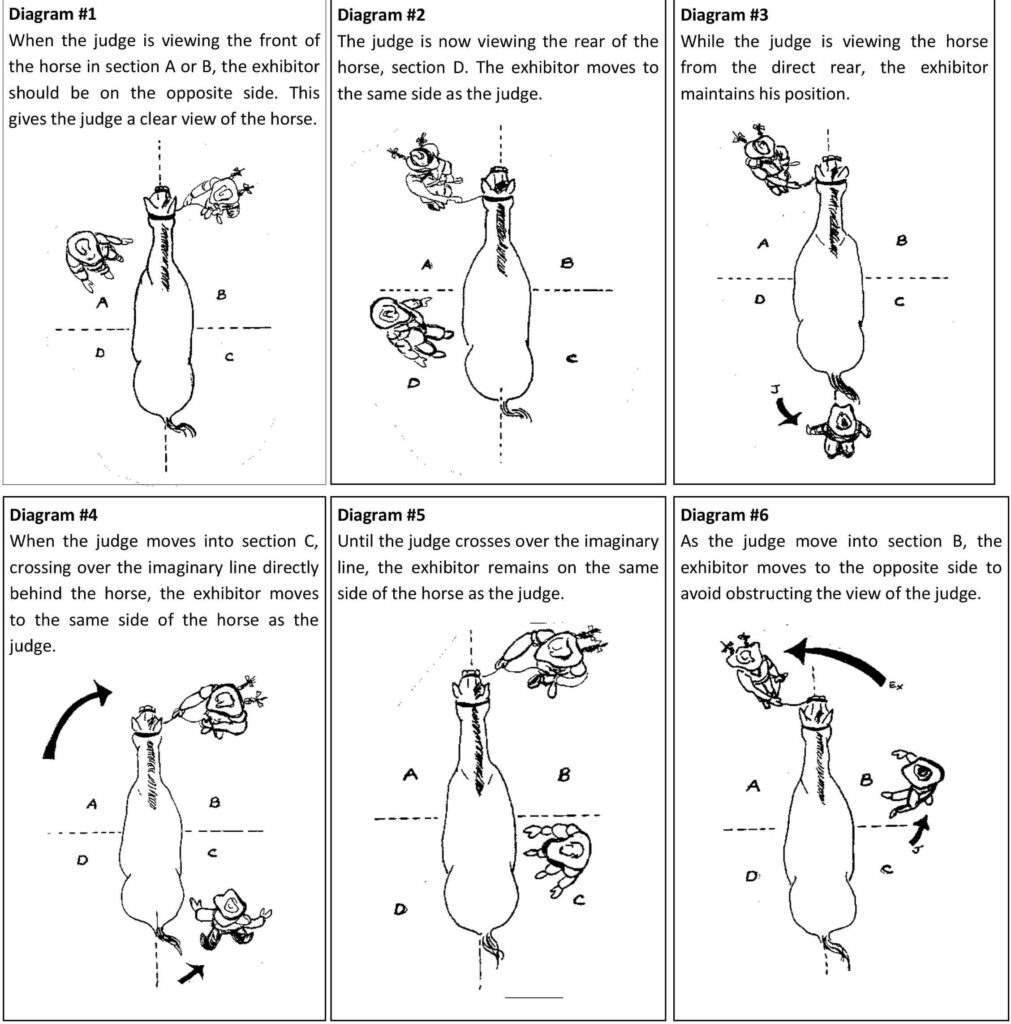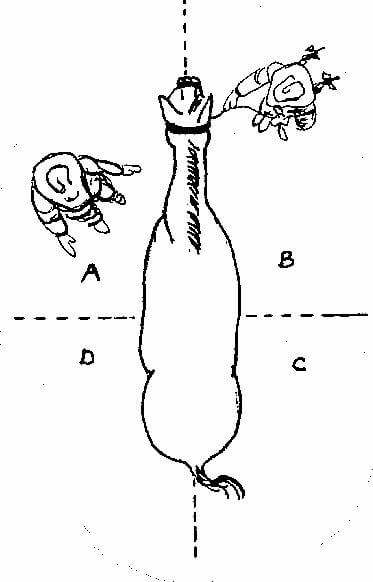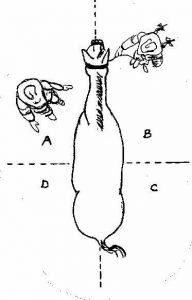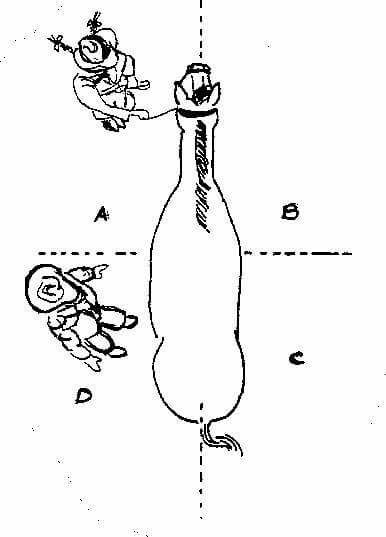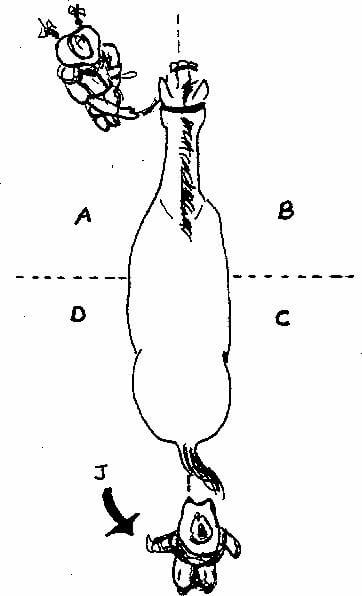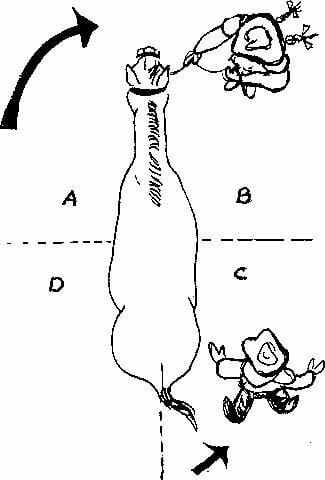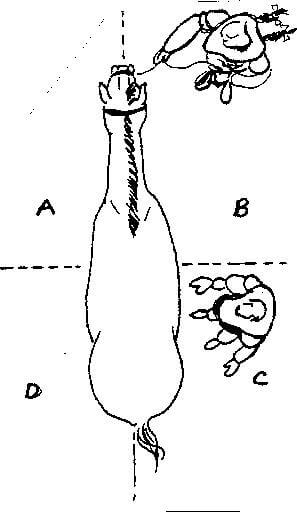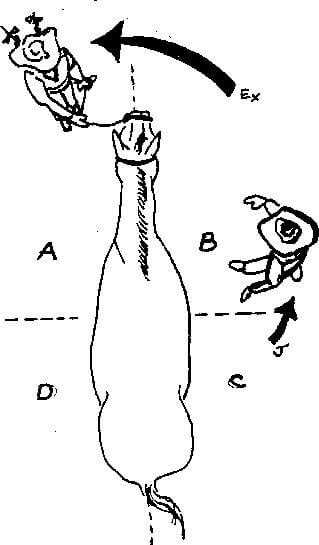Table of Contents
- Showmanship at halter. Available only in the amateur and youth divisions, showmanship is designed to evaluate the exhibitor’s ability to execute, in concert with a well groomed and conditioned mule, a set of maneuvers prescribed by the judge with precision and smoothness while exhibiting poise and confidence, and maintaining a balanced, functional and fundamentally correct body position.
- It is mandatory that the judge post the initial pattern to be worked at least one hour prior to the commencement of the class; however, if the judge requires additional work of exhibitors for consideration of final placing, an additional pattern may be posted. Pattern(s) should be designed to test the showman’s ability to effectively present a mule to the judge. All ties will be broken at the judge’s discretion.
- Class procedures: All exhibitors may enter the ring and then work individually or each exhibitor may be worked from the gate individually. When exhibitors are worked individually from the gate, a working order is required. The following maneuvers are considered acceptable: lead the mule at a walk, jog, trot or extended trot, or back in a straight or curved line, or a combination of straight and curved lines; stop; and turn 90 (1/4), 180 (1/2), 270 (3/4), 360 (full turn) degrees or any combination or multiple of these turns. The pull turn is an unacceptable maneuver. The judge must have exhibitors set the mule up squarely for inspection sometime during the class.
- Showmanship whips (dressage whips etc.), war bridles or like devices, or any type of wire or rope over a mule’s head are not permitted for showmanship purposes.
- A minimum gauge link of 4.0 mm is required.
- Scoring: Exhibitors are to be scored from 0 to infinity, with 70 denoting an average performance. Patterns will be divided into 6 to 10 maneuvers, as specified by the judge, and each maneuver will be scored from +3 to -3 with 1/2 point increments acceptable that will be added or subtracted from 70. Maneuver scores should be determined independent of penalties and should reflect equal consideration of both the performance of the exhibitor’s pattern and the form and effectiveness of the exhibitor and presentation of mule to result in the following scores: +3 Excellent, +2 Very Good, +1 Good, 0 Average or Correct, -1 Poor, -2 Very Poor, -3 Extremely Poor. Exhibitors overall form and effectiveness should also be scored from 0 to 5 with 0 to 2 Average, 3 Good, 4 Very Good, 5 Excellent.
- Overall Presentation of Exhibitor and Mule. The exhibitor’s overall poise, confidence, appearance, and position throughout the class, and the physical appearance of the mule will be evaluated. Presentation and Position of Exhibitor. Appropriate western attire must be worn; clothes and person are to be neat and clean. The use of any type of artificial aid, including, but not limited to, lighters, hay, dirt, sharp pins, magnetic devices, etc., will result in a disqualification.
- Exhibitors should be poised, confident, courteous, and genuinely sportsmanlike at all times, quickly recognizing and correcting faults in the positioning of the mule. The exhibitor should continue showing the mule until the class has been placed or they have been excused unless otherwise instructed by the judge. The exhibitor should appear business-like, stand and move in a straight, natural, and upright manner, and avoid excessive, unnatural, or animated body positions.
- The exhibitor must lead on the mule’s left side, holding the lead shank in the right hand near the halter with the tail of the lead loosely coiled in the left hand unless requested by the judge to show the mule’s teeth. It is preferable that the exhibitor’s hand not be on the snap or chain portion of the lead continuously. The excess lead should never be tightly coiled, rolled, or folded. When leading, the exhibitor should be positioned between the eye and the mid-point of the mule’s neck, referred to as the leading position.
- Both arms should be bent at the elbow with the elbows held close to the exhibitor’s side and the forearms held in a natural position. Height of the arms may vary depending on the size of the mule and exhibitor, but the arms should never be held straight out with the elbows locked.
- The position of the exhibitor when executing a turn to the right is the same as the leading position except that the exhibitor should turn and face toward the mule’s head and have the mule move away from them to the right.
- When executing a back, the exhibitor should turn from the leading position to face toward the rear of the mule with the right hand extended in front of the exhibitor’s chest still maintaining slight bend in the elbow and walk forward. The ideal position is for the exhibitors left shoulder to be in alignment with the mule’s left front leg.
- When setting the mule up for inspection, the exhibitor should stand angled toward the mule in a position between the mule’s eye and muzzle and should never leave the head of the mule. The exhibitor is required to use the Quarter Method when presenting the mule. The exhibitor should maintain a position that is safe for themselves and the judge. The position of the exhibitor should not obstruct the judge’s view of the mule and should allow the exhibitor to maintain awareness of the judge’s position at all times. The exhibitor should not crowd other exhibitors when setting up side-by-side or head-to-tail. When moving around the mule, the exhibitor should change sides in front of the mule with minimal steps and should assume the same position on the right side of the mule that they had on the left side.
- Leading, backing, turning and initiating the set-up should be performed from the left side of the mule. At no time should the exhibitor ever stand directly in front of the mule. The exhibitor should not touch the mule with their hands or feet, or visibly cue the mule by pointing their feet at the mule during the set-up.
- Presentation of Mule. The mule’s body condition and overall fitness should be assessed. The hair coat should be clean, well-brushed, and in good condition. The mane, tail, forelock, and wither tuft may not contain ornaments (ribbons, bows, etc.) but may be braided or banded for English or Western. The length of the mane and tail may vary as long as they are neat, clean, and free of tangles. The mane should be even in length or may be roached, including forelock and tuft over withers. The bridle path, eyebrows, and long hair on the head and legs may be clipped, except where government regulations prohibit. Hooves should be properly trimmed, and if shod, the shoes should fit correctly, and clinches should be neat. Hooves must be clean and may be painted black or with hoof dressings or shown naturally. The tack should fit properly and be neat, clean, and in good repair.
- Pattern Performance. The exhibitor should perform the work accurately, precisely, smoothly, and with a reasonable amount of speed. Increasing the speed of the work increases the degree of difficulty. However, accuracy and precision should not be sacrificed for speed. The mule should lead, stop, back, turn, and set up willingly, briskly, and readily with minimal visible or audible cueing.
- The mule should be led directly to and away from the judge in a straight or curved line and track briskly and freely at the prescribed gait as instructed. The mule’s head and neck should be straight and in line with the body.
- The stop should be straight, prompt, smooth, and responsive, with the mule’s body remaining straight.
- The mule should back up readily with the head, neck, and body aligned in a straight or curved line as instructed.
- On turns of greater than 90 degrees, the ideal turn consists of the mule pivoting on the right hind leg while stepping across and in front of the right front leg with the left front leg. An exhibitor should not be penalized if their mule performs a pivot on the left hind leg, but an exhibitor whose mule performs the pivot correctly should receive more credit.
- A pull turn to the left is an unacceptable maneuver.
- The mule should be set up quickly with the feet squarely underneath the body. The exhibitor does not have to reset a mule that stops square.
- Penalties. Maneuver evaluations and penalty applications are to be determined independently. The following penalties will be applied for each occurrence and will be deducted from the final score:
- Three (3) points
- Break of gait at the walk or trot up to 2 strides
- Over or under turning up to1/8 of a turn
- Ticking or hitting the cone
- Sliding a pivot foot
- Lifting a pivot foot during a pivot and replacing it in the same place
- Lifting a foot in a set-up and replacing it in the same place after the presentation
- Five (5) points
- Not performing the specific gait or not stopping within 10 feet (3 meters) of the designated location
- Break of gait at walk or trot for more than 2 strides
- Splitting the cone (cone between the mule and exhibitor)
- Mule stepping out of or moving the hind end significantly during a pivot or turn
- Mule stepping out of set-up after presentation
- Mule resting a foot or hipshot in a set-up
- Over or under turning 1/8 to 1/4 turn
- Ten (10) points
- Exhibitor is not in the required position during inspection
- Exhibitor touching the mule or kicking or pointing their feet at the mule’s feet during the set-up
- Standing directly in front of the mule
- Loss of lead shank, holding chain or two hands on shank
- Blatant disobedience, including biting, kicking, rearing, or pawing; mule continually circling exhibitor
- Twenty (20) points
- Exhibitor’s going off pat-tern, knocking over or on wrong side of cone, never performing specified gait, or overturning more than 1/4 turn than designated, shall not be disqualified, but must always place below exhibitors not incurring a major (20 point) fault.
- Disqualifications (should not be placed) include:
- Loss of control of mule that endangers exhibitor, other horses, or judge
- Mule becomes separated from the exhibitor
- Failure to display the correct number
- Willful abuse
- Excessive schooling or training; use of artificial aids and illegal equipment
- Three (3) points
Showmanship Diagram #
